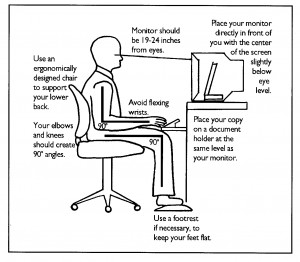|
VOCAL HEALTH If You Can't Stand Up When Voicing, Here's The Best Posture For Sitting ... May 28, 2015  By Ann S. Utterback, Ph.D. Voice Specialist By Ann S. Utterback, Ph.D. Voice Specialist Author, Broadcaster's Survival Guide I’m a big fan of standing when voicing, but of course, that’s not always possible. My associate, Cathy Runnels, explains, "Many broadcasters and voice over professionals sit a lot, and for long periods of time.” She’s exactly right, so here’s what she suggests to correct your posture when seated ... POSTURE AND YOUR VOICE Few people are aware that posture supports a functioning respiratory system, which in turn supports good voicing skills. The skeletal system is the frame that houses the internal organs and structures for sound and speech. Bending the shoulders even slightly compresses the abdomen, making it harder for the diaphragm to support breathing. Jutting the head forward, putting weight on one side, swaying the back, are among many positions that can create misalignment of the skeletal system. This can make it hard to breathe easily and to use that breath for maximum voicing. Here are some tips on how to improve your posture when seated:
------------------------ ABOUT CATHY Cathy Runnels, M.S., CCC-SLP is a Voice and Communications Specialist based in the Washington, DC metroplex. Web: www.aospeech.com Email: crunnels@aospeech.com --------------------------------------------  ABOUT ANN ABOUT ANNAnn
S. Utterback, Ph.D., is a voice specialist with more than 40 years
experience and has helped hundreds of people make the most of their
voices, working with broadcasters, voice over artists and podcasters
around the world. An author of eight books and over 50 articles on
voice, her Broadcaster's Survival Guide
e-book offers more tips on dealing with holiday stress, plus advice on
how to improve your voice over performance by making simple lifestyle
changes.
Web: http://OnlineVoiceCoaching.comClick for: Broadcaster's Survival Guide If you read my blog regularly, you know I’m a big fan of standing when voicing, but that’s not always possible. My associate, Cathy Runnels, explains, "Many broadcasters and voiceover professionals sit a lot, and for long periods of time.” She’s exactly right, so here’s what she suggests to correct your posture when seated: "Few people are aware that posture supports a functioning respiratory system, which in turn supports good voicing skills. The skeletal system is the frame that houses the internal organs and structures for sound and speech. Bending the shoulders even slightly compresses the abdomen, making it harder for the diaphragm to support breathing (for an explanation, watch this short video). Jutting the head forward, putting weight on one side, swaying the back, are among many positions that can create misalignment of the skeletal system. This can make it hard to breathe easily and to use that breath for maximum voicing. Here are some tips on how to improve your posture when seated:
Use these concepts to create a good sitting position that will ultimately support your best voice.” Cathy Runnels, M.S., CCC-SLP is a Voice and Communications Specialist based in the Washington DC metroplex. To learn more about Ms. Runnels, go to: www.aospeech.com, phone her office at 301 879-1981, or email at crunnels@aospeech.com. - See more at: http://onlinevoicecoaching.com/?page_id=1247&mc_cid=d69d00d566&mc_eid=a06e28dbfb#sthash.d1Z1q2E4.dpuf |
Tell Us What YOU Think!
Please Note: Since we check for spam, there will be a slight delay in the actual posting of your comment.
Comments (2)
Debbie Grattan
6/1/2015 at 3:57 PM
This is so important. I shared with my husband (who's having some bad upper back pain) and daughter (teenage sloucher). I now sit at my computer on an exercise ball, and I have a separate task table that sits a bit lower than my desk, to accommodate my arms, wrists and shoulders while working on the computer. I now stand all the time, when I'm voicing at the mic.
Howard Ellison
5/29/2015 at 4:57 AM
For sure, the voice changes - generally for the better - when standing. But on a long read, a note of fatigue may creep in. One compromise is a tall saddle-stool as used by hair stylists/dentists... so you can be upright, breathing freely as Ann suggests, and free to wave your arms around, but some weight is taken away from your legs. Legs straight, feet planted on floor. Height adjustment is critical if you want to steer clear of Cyclist's Lament, and of course the stool must not creeeeak.
As of the NEW website launch, 03/22/2012

 Take note of your seated posture when you’re rested and
also when you’re fatigued.
Take note of your seated posture when you’re rested and
also when you’re fatigued.








.png)
click for new article alerts